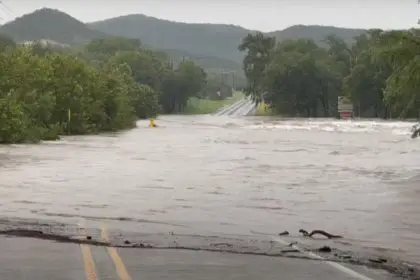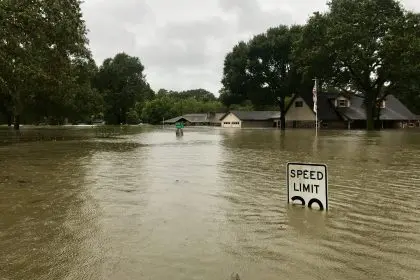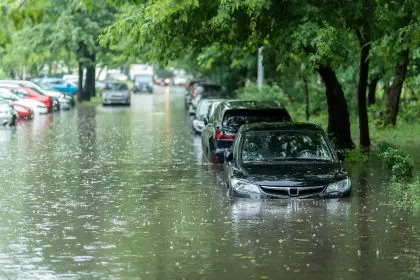A catastrophic weather event struck Newark Valley and surrounding areas as 5 inches of rain fell in just 3 hours, unleashing devastating flash floods that transformed peaceful neighborhoods into dangerous waterways and forced the closure of major highways throughout the Southern Tier region.
The meteorological disaster began with what appeared to be ordinary rainfall but rapidly escalated into a life-threatening emergency that overwhelmed local infrastructure and trapped residents in their homes and vehicles. Emergency crews found themselves racing against time to conduct water rescues while battling rising waters that showed no signs of retreat.
Streets vanish beneath rushing waters
Main Street in Newark Valley completely disappeared under the relentless surge of floodwater, transforming the community’s commercial heart into an impassable river. The familiar thoroughfare that residents navigate daily became unrecognizable as murky water rushed through the business district, creating hazardous conditions for anyone attempting to venture outside.
Russel Road faced a similar fate, with water levels rising so rapidly that residents had little time to prepare for the emergency unfolding outside their doors. The flooding on this residential street brought the crisis directly to families who suddenly found themselves surrounded by dangerous, swift-moving water that threatened their safety and property.
The speed at which these neighborhood streets transformed into flood zones caught many residents off guard, highlighting the unpredictable nature of flash flooding events that can develop within minutes of heavy rainfall beginning.
Major highways become impassable
The flooding crisis extended far beyond Newark Valley’s borders, creating a transportation nightmare across the entire Southern Tier region. Route 38 became completely impassable between Rock Street and Mill Street in Newark Valley, forcing authorities to turn vehicles around with no detour options available for stranded motorists.
Route 26 suffered even more extensive damage, with floodwaters overwhelming both directions near Pollard Hill Road in Maine and Dunham Hill Road in Whitney Point. All lanes became blocked, creating a significant disruption for emergency services trying to reach affected areas while leaving drivers with no alternative routes.
The situation on Route 7 near Brandywine Avenue required complex traffic management as all lanes in both directions became flooded. Emergency officials established an intricate detour system, directing northbound traffic along Brandywine Avenue to Henry Street, then to Chenango Street, and finally to Eldridge Street, with southbound travelers following the reverse route.
Local roads overwhelmed by deluge
Beyond the major highways, numerous local roads throughout the region became casualties of the extreme weather event. The National Weather Service reported that Nanticoke Road in Maine had been completely covered by water, making it impossible for vehicles to safely traverse the area.
The Glen Aubrey Fire Company issued comprehensive alerts about multiple road closures affecting their service area, including Rabbit Path, Cherry Valley Hill Road extending to Lamb Road, Route 26 south of the fire station, and the critical stretch from Caldwell Hill Road to Henry M Baldwin to Greenwood Road. These closures created a complex network of blocked routes that significantly impacted regional transportation.
Emergency response stretches resources thin
Local emergency crews demonstrated extraordinary courage as they conducted multiple water rescue operations throughout the affected communities. First responders faced the challenging task of navigating treacherous floodwaters while ensuring the safety of residents trapped in vehicles and homes across the region.
The water rescue operations required specialized equipment and extensive coordination as emergency personnel worked to safely extract people from dangerous situations. These brave responders risked their own safety to help neighbors during this terrifying ordeal, often working in conditions where visibility was poor and water currents were unpredictable.
The widespread nature of the emergency stretched local resources to their limits, with crews responding to simultaneous calls for help across multiple communities. The coordination required to manage such an extensive emergency response showcased both the dedication of local emergency services and the challenges faced during large-scale weather disasters.
Community grapples with aftermath
As emergency response efforts continue, residents throughout the Southern Tier region are beginning to assess the extensive damage caused by this unprecedented weather event. The impact on homes, businesses, and critical infrastructure will likely require weeks or months of recovery efforts, creating ongoing challenges for affected communities.
The psychological impact of witnessing familiar neighborhoods and major highways transform into dangerous flood zones cannot be understated. Residents who experienced this sudden and severe weather emergency will likely carry these memories for years to come, forever changing their perception of their community’s vulnerability to extreme weather events.
This flash flooding event serves as a stark reminder of how quickly weather conditions can deteriorate and create life-threatening situations across multiple communities simultaneously, emphasizing the importance of regional emergency preparedness and the critical role of coordinated response efforts.
















